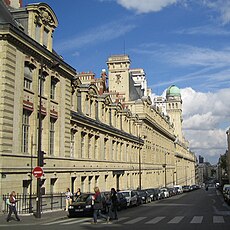History
Formerly lying along the cardo of Roman Lutetia, this street was a main axial road of medieval Paris, as the buildings that still front it attest. It is the historic starting point, at no. 252, the Église Saint-Jacques-du-Haut-Pas, for pilgrims leaving Paris to make their way along the Chemin de Saint-Jacques that led eventually to Santiago de Compostela (James, Jacques, Jacob, and Iago being names of the same saint in English, French, Latin, and Spanish, respectively). However, the introduction of the Boulevard Saint-Michel, constructed through this old quarter of Paris by Baron Haussmann, relegated the roughly parallel Rue Saint-Jacques to a backstreet. [1]
The Paris base of the Dominican Order was established in 1218 under the leadership of Pierre Seilhan (or Seila) in the Chapelle Saint-Jacques, close to the Porte Saint-Jacques, on this street; this is why the Dominicans were called Jacobins in Paris. Thus the street's name is indirectly responsible for the Jacobin Club in the French Revolution getting that name (being based in a former Jacobin monastery, itself located elsewhere). Johann Heynlin and Guillaume Fichet established the first printing press in France, briefly at the Sorbonne and then on this street, in the 1470s. The second printers in Paris were Peter Kayser and Johann Stohl at the sign of the Soleil d'Or in the Rue Saint-Jacques, from 1473. [2] The proximity of the Sorbonne led many later booksellers and printers to set up shop here also.
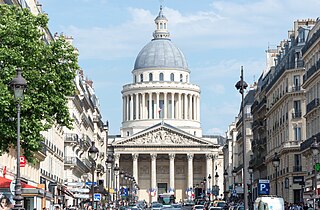
The 5th arrondissement of Paris is one of the 20 arrondissements of the capital city of France. In spoken French, this arrondissement is referred to as le cinquième.

Saint-Jacques is a station on Line 6 of the Paris Métro. It serves Place Saint-Jacques in the 14th arrondissement. The Boulevard Saint-Jacques and Rue du Faubourg-Saint-Jacques also intersect the square. It is one of only a few Métro stations that have a combined entrance and ticket hall at street-level.

The Tour Saint-Jacques is a monument located in the 4th arrondissement of Paris, France, at the intersection of Rue de Rivoli with Rue Nicolas Flamel. This 52-metre (171 ft) Flamboyant Gothic tower is all that remains of the former 16th-century Church of Saint-Jacques-de-la-Boucherie, which was demolished in 1797, during the French Revolution, leaving only the tower.

The Rue du Faubourg Saint-Honoré is a street located in the 8th arrondissement of Paris, France. Relatively narrow and nondescript, especially in comparison to the nearby Avenue des Champs-Élysées, it is cited as being one of the most luxurious and fashionable streets in the world thanks to the presence of major global fashion houses, the Élysée Palace, the Hôtel de Pontalba, the Embassy of Canada, the Embassy of the United Kingdom, as well as numerous art galleries.

The Boulevard Saint-Michel is one of the two major streets in the Latin Quarter of Paris, France, the other being the Boulevard Saint-Germain. It is a tree-lined boulevard which runs south from the Pont Saint-Michel on the Seine and Place Saint-Michel, crosses the Boulevard Saint-Germain and continues alongside the Sorbonne and the Jardin du Luxembourg, ending at the Place Camille Jullian just before the Port-Royal RER station and the Avenue de l'Observatoire. It was created by Baron Haussmann to run parallel to the Rue Saint-Jacques which marks the historical north-south axis of Paris. It is known colloquially as Boul'Mich' in French.

The Rue Saint-Honoré is a street in the 1st arrondissement of Paris, France. It is named after the collegial Saint-Honoré church, situated in ancient times within the cloisters of Saint-Honoré.
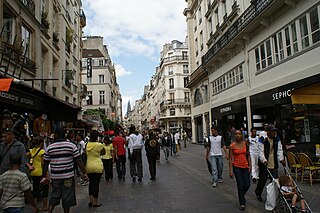
The Rue Saint-Denis is one of the oldest streets in Paris. Its route was first laid out in the 1st century by the Romans, and then extended to the north in the Middle Ages. From the Middle Ages to the present day, the street has been notorious as a place of prostitution. Its name derives from it being the historic route to Saint-Denis.
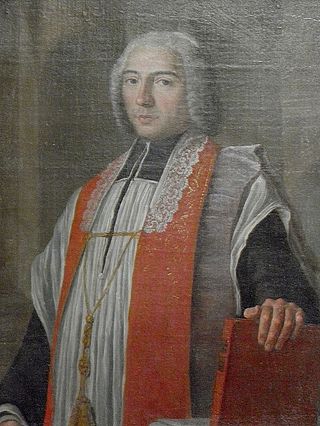
Jean-Denis Cochin was a French Roman Catholic priest, preacher and philanthropist. In 1780, he founded Paris's Hôpital Cochin, as the hospice of Saint-Jacques du Haut Pas, in the rue du Faubourg Saint-Jacques.

The Hôpital Cochin is a hospital of public assistance in the rue du Faubourg-Saint-Jacques Paris 14e. It houses the central burn treatment centre of the city. The Hôpital Cochin is a section of the Faculté de Médecine Paris-Cité. It commemorates Jean-Denis Cochin, curé of the parish of Saint-Jacques-du-Haut-Pas and founder of a hospital for the workers and poor of that quarter of Paris.
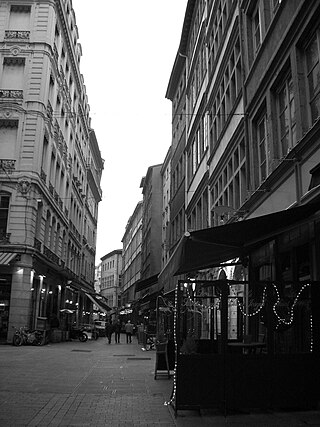
Rue Mercière is a street of Les Cordeliers quarter in the 2nd arrondissement of Lyon. From north to south, it connects the Place des Jacobins to the Place d'Albon. This street is served by metro stations Bellecour and Cordeliers of the line and by the bus station Jacobins of the lines 91 and 99. It belongs to the zone classified as World Heritage Site by UNESCO.

The Place des Jacobins is a square located in the 2nd arrondissement of Lyon. It was created in 1556 and a fountain was added in 1856. The square belongs to the zone classified as World Heritage Site by UNESCO. According to Jean Pelletier, this square is one of the most famous in Lyon, because of its location in the center of the 2nd arrondissement and its heavy traffic, as 12 streets lead here. The square, particularly its architecture and its features, has changed its appearance many times throughout years.
The Rue Édouard-Herriot is one of the most important shopping streets of the Presqu'île in Lyon. It links the two most famous places of the city, the Place Bellecour (south) and the Place des Terreaux (north). Its northern part is located in the 1st arrondissement of Lyon, but the main part of the street is in the 2nd arrondissement. In its southern part, the street passes through the Place des Jacobins. It belongs to the zone classified as World Heritage Site by UNESCO.

Saint-Jacques du Haut-Pas is a Roman Catholic parish church in Paris, France. The church is located at the corner of Rue Saint-Jacques and Rue de l'Abbé de l'Épée in the 5th arrondissement of Paris. The first church on the site, a monastery chapel, was built in 1360. The present church was completed in 1685. The church is named for Saint-Jacques Du-Haut-Pas,", a cousin of Christ and the first bishop of Jerusalem, who was martyred in the year 60 A.D. It was registered as an historical monument on 4 June 1957.

Daniel Kern Manufacture d'Orgues were an organ builder based in Strasbourg, France. Their organs were installed in many churches in France and other countries. In addition, the firm undertook restoration work on historic organs.
Claude-François Clicquot was a French organ-builder, son of the celebrated François-Henri Clicquot. During and after the French Revolution he saved many organs in Paris and in the provinces.

Saint-Joseph-des-Carmes (Saint-Joseph-des-Carmes) is a Catholic church located at 70 rue de Vaugirard in the 6th arrondissement of Paris. It was originally built as the chapel of a convent of the mendicant order of Shoeless Carmelites. It is now the church of the Catholic Institute of Paris, a university-level seminary for training priests, and is also a parish church for the neighbourhood. It is dedicated to Saint Joseph, husband of the Virgin Mary. Built between 1613 and 1620, it combines elements of Classical architecture on the exterior with a remarkable display of Baroque architecture and art in the interior. The chapel is open to the public at limited hours.
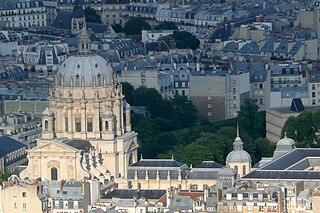
The quartier du Val-de-Grâce is the 19th administrative district or 'quartier' of Paris, located in the 5th arrondissement of the city. Its borders are boulevard de Port-Royal to the south, boulevard Saint-Michel to the west, rue Soufflot, rue des Fossés-Saint-Jacques and rue de l'Estrapade to the north and rue Mouffetard and rue Pascal to the east.

The Rue du Cloître-Saint-Benoît was a now-disappeared street in the Sorbonne district of Paris, demolished to build the present Rue des Écoles. It was named after the cloister of the église Saint-Benoît-le-Bétourné, and just before the French Revolution, it fell within that church's parish. It was made part of the Chalier sector during the Revolution; that sector was renamed the Sorbonne district when the original 11th arrondissement of Paris was formed in 1795.

The Institut océanographique de Paris, is an oceanographic institution founded in 1906 by Albert I, Prince of Monaco, which also includes the Oceanographic Museum of Monaco. The building was designated as a Monument historique in 2004. In 2011, for the 100 year anniversary, it was renamed the Maison de l'Océan.
